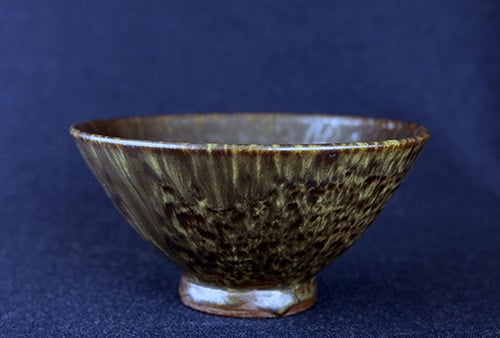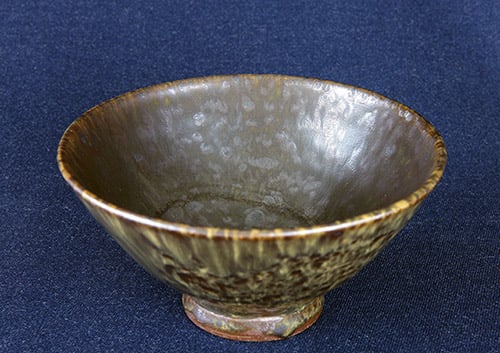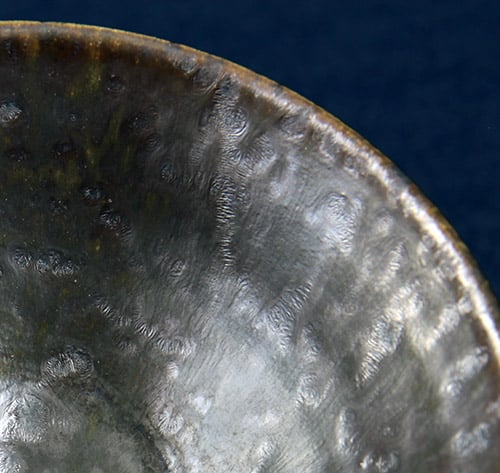Page 23 of 28
Re: The unofficial/official Korean Teaware Topic
Posted: Mar 30th, '13, 09:53
by edkrueger
I've never seen a Japanese bowl that has quite copied the Korean ones. For one, Japanese bowls usually don't have exposed spots at the center of the bowl. I think this for reasons related to whisking.
I'm pretty sure it is Korean, but if some Japanese potter accomplished the same effect I'd like to know.
Re: The unofficial/official Korean Teaware Topic
Posted: Mar 30th, '13, 10:36
by Tead Off
edkrueger wrote:I've never seen a Japanese bowl that has quite copied the Korean ones. For one, Japanese bowls usually don't have exposed spots at the center of the bowl. I think this for reasons related to whisking.
I'm pretty sure it is Korean, but if some Japanese potter accomplished the same effect I'd like to know.
Do Korean bowls usually have exposed spots at the center of the bowl?
Re: The unofficial/official Korean Teaware Topic
Posted: Mar 30th, '13, 10:44
by tingjunkie
Tead Off wrote:Maybe not Korean, but in the style of.
As I said, I'm just starting to learn about Ido chawan and know pretty much nothing. What qualities lead you to believe it's not Korean?
Re: The unofficial/official Korean Teaware Topic
Posted: Mar 30th, '13, 11:04
by Tead Off
tingjunkie wrote:Tead Off wrote:Maybe not Korean, but in the style of.
As I said, I'm just starting to learn about Ido chawan and know pretty much nothing. What qualities lead you to believe it's not Korean?
It was a comment by a Korean potter. There's some gray area that photos don't clarify. It's kohiki style but Japanese copied a lot, too. Again, asking someone like Arthur Park could be helpful. He might be able to identify a design element that is not consistent with Korean work. Why there are empty area in the bowl, I wouldn't know. Could be a mistake, a kiln effect, etc. I take it those are stains on the interior that give it that look?
Re: The unofficial/official Korean Teaware Topic
Posted: Mar 30th, '13, 11:13
by tingjunkie
The three clay spots on the bottom are there because, being mass produced, they would stack multiple bowls up in the kiln to be fired at the same time. They placed three small clay balls there so that the glaze on each bowl would not fuse and stick with the bowls above and below.
Maybe the top bowl in the stack had more collector value to the Japanese? Not sure if the famous Kazaemon Ido bowl had the three marks or not, but given the wabi aesthetic, I'd guess it did.
Re: The unofficial/official Korean Teaware Topic
Posted: Mar 30th, '13, 11:57
by Tead Off
tingjunkie wrote:The three clay spots on the bottom are there because, being mass produced, they would stack multiple bowls up in the kiln to be fired at the same time. They placed three small clay balls there so that the glaze on each bowl would not fuse and stick with the bowls above and below.
Maybe the top bowl in the stack had more collector value to the Japanese? Not sure if the famous Kazaemon Ido bowl had the three marks or not, but given the wabi aesthetic, I'd guess it did.
Yes, I forgot that they did that and I missed the 3rd spot on yours. But, I believe Japanese potters did this too.
Re: The unofficial/official Korean Teaware Topic
Posted: Mar 30th, '13, 15:31
by TIM
Tead Off wrote:tingjunkie wrote:Tead Off wrote:Maybe not Korean, but in the style of.
As I said, I'm just starting to learn about Ido chawan and know pretty much nothing. What qualities lead you to believe it's not Korean?
It was a comment by a Korean potter. There's some gray area that photos don't clarify. It's kohiki style but Japanese copied a lot, too. Again, asking someone like Arthur Park could be helpful. He might be able to identify a design element that is not consistent with Korean work. Why there are empty area in the bowl, I wouldn't know. Could be a mistake, a kiln effect, etc. I take it those are stains on the interior that give it that look?
Could you by any chance have the work of the Korean potter that gave you this comment. I am very curious on seeing more traditional korean potter's work. A Big Thank You in Advice TO! Toki
Re: The unofficial/official Korean Teaware Topic
Posted: Mar 31st, '13, 01:34
by Tead Off
TIM wrote:Tead Off wrote:tingjunkie wrote:Tead Off wrote:Maybe not Korean, but in the style of.
As I said, I'm just starting to learn about Ido chawan and know pretty much nothing. What qualities lead you to believe it's not Korean?
It was a comment by a Korean potter. There's some gray area that photos don't clarify. It's kohiki style but Japanese copied a lot, too. Again, asking someone like Arthur Park could be helpful. He might be able to identify a design element that is not consistent with Korean work. Why there are empty area in the bowl, I wouldn't know. Could be a mistake, a kiln effect, etc. I take it those are stains on the interior that give it that look?
Could you by any chance have the work of the Korean potter that gave you this comment. I am very curious on seeing more traditional korean potter's work. A Big Thank You in Advice TO! Toki
It was a comment made by Seong il when I showed him the photos asking him if he thought this was Korean made. He had doubts of its Korean origin but didn't imply that it was definitely not Korean. These things can be difficult from photos and even handling the real things. He is not making himself out to be an expert. Many potters study traditional work in their training. What did Arthur Park say about the pieces you and Brandon have?
Re: The unofficial/official Korean Teaware Topic
Posted: Apr 2nd, '13, 13:35
by hopeofdawn
Whether Korean or Japanese, it's an amazing piece--kudos! The lighter areas on the interior almost look like an antique map to some strange world ....
Re: The unofficial/official Korean Teaware Topic
Posted: Apr 2nd, '13, 22:06
by tingjunkie
hopeofdawn wrote:Whether Korean or Japanese, it's an amazing piece--kudos! The lighter areas on the interior almost look like an antique map to some strange world ....
That's a great description! Thanks hope.

Re: The unofficial/official Korean Teaware Topic
Posted: Apr 3rd, '13, 15:53
by Vega
While in Seoul, I was browsing the teaware shops along Insa-Dong (dangerous!), when this beauty caught my eye:

- Korean bowl, 1
- IMG_5287.JPG (21.15 KiB) Viewed 1778 times
The artist is Kim Song Bae. It's the first Korean bowl in my collection, and I've never seen one quite like this. It uses an oak tree ash glaze, and is fired at 1400 degrees. The inside has small ridges, in palm print like patterns:

- Korean bowl 2
- IMG_5292.JPG (39.08 KiB) Viewed 1778 times
Here's a closeup:

- Closeup
- korean_teabowl_closeup.jpg (39.58 KiB) Viewed 1778 times
Is this a common type of style and glaze?
Re: The unofficial/official Korean Teaware Topic
Posted: Apr 3rd, '13, 16:10
by yalokinh
whoa!!! congrats to finding this. beautiful
Re: The unofficial/official Korean Teaware Topic
Posted: Apr 3rd, '13, 17:29
by brandon
The style looks like a modern take on a very old Chinese style. The Japanese refer to this as tenmoku. Original name is tianmu.
The unofficial/official Korean Teaware Topic
Posted: Apr 3rd, '13, 18:04
by debunix
Ooh la la!
Re: The unofficial/official Korean Teaware Topic
Posted: Apr 4th, '13, 10:04
by Tead Off
Seong il and a few other Korean potters have been invited to exhibit in Yixing, China at an International fair on May 5, 2013. Hopefully, our Chinese friends who are living in Shanghai and the neighboring vicinity, or even in other parts of China, can visit the fair and meet Seong il and enjoy this pottery festival. It will be Seong il's first time in China, I believe. How exciting for him. Will Yixing ever be the same after this event?
